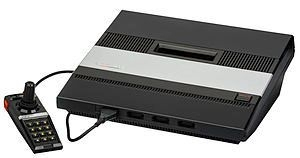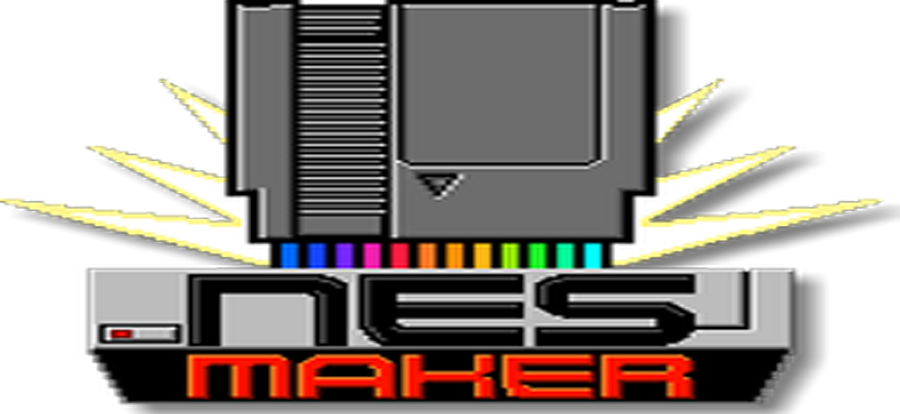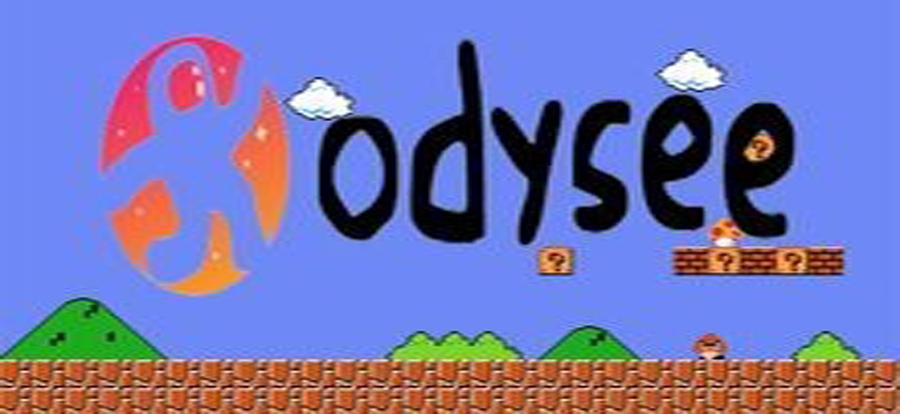

Atari 5200
From Wikipedia, the free encyclopedia
Atari 5200 Atari-5200-4-Port-wController-L.jpg
Atari 5200 system and controller
Manufacturer Atari Inc.
Type Home video game console
Generation Second generation
Retail availability
NA: November 1982
Discontinued May 21, 1984
Units sold 1 million
Media ROM cartridge
CPU MOS 6502C @ 1.79 MHz
Controller input Joystick
Trak-Ball
Predecessor Atari 2600
Successor Atari 7800
The Atari 5200 SuperSystem, commonly known as the Atari 5200, is a home video game console that was introduced in 1982 by Atari Inc. as a higher-end complementary console for the popular Atari 2600. The 5200 was created to compete with the Intellivision, but wound up more directly competing with the ColecoVision shortly after its release.
The 5200's internal hardware is almost identical to that of Atari's 8-bit computers, although software is not directly compatible between the two systems. The 5200's controllers have an analog joystick and a numeric keypad along with start, pause and reset buttons. The 360-degree non-centering joystick was touted as offering more control than the eight-way joystick controller offered with the Atari 2600.
Hardware
The 5200's large size is due in part to controller storage in the back of the unit.Much of the technology in the Atari 8-bit family of home computer systems was originally developed as a second-generation games console intended to replace the 2600. However, as the system was reaching completion, the personal computer revolution was starting with the release of machines like the Commodore PET, TRS-80 and Apple II. These machines had less advanced hardware than the new Atari technology, but sold for much higher prices with associated higher profit margins. Atari's management decided to enter this market, and the technology was repackaged into the Atari 400 and 800. The chipset used in these machines was created with the mindset that the 2600 would likely be obsolete by the 1980 time frame.
Atari later decided to re-enter the games market with a design that closely matched their original 1978 specifications. In its prototype stage, the Atari 5200 was originally called the "Atari Video System X – Advanced Video Computer System", and was codenamed "Pam" after a female employee at Atari Inc. It is also rumored that PAM actually stood for "Personal Arcade Machine", as the majority of games for the system ended up being arcade conversions. Actual working Atari Video System X machines, whose hardware is 100% identical to the Atari 5200 do exist, but are extremely rare.
The initial 1982 release of the system featured four controller ports, where nearly all other systems of the day had only one or two ports. The 5200 also featured a new style of controller with an analog joystick, numeric keypad, two fire buttons on each side of the controller and game function keys for Start, Pause, and Reset. The 5200 also featured the innovation of the first automatic TV switchbox, allowing it to automatically switch from regular TV viewing to the game system signal when the system was activated. Previous RF adapters required the user to slide a switch on the adapter by hand. The RF box was also where the power supply connected in a unique dual power/television signal setup similar to the RCA Studio II's. A single cable coming out of the 5200 plugged into the switch box and was used for both electricity and the television signal.
The 1983 revision of the Atari 5200 has two controller ports instead of four, and a change back to the more conventional separate power supply and standard non-autoswitching RF switch. It also has changes in the cartridge port address lines to allow for the Atari 2600 adapter released that year. While the adapter was only made to work on the two-port version, modifications can be made to the four-port to make it line-compatible. In fact, towards the end of the four-port model's production run, there were a limited number of consoles produced which included these modifications. These consoles can be identified by an asterisk in their serial numbers.
Controllers
The Atari 5200 controller
The controller prototypes used in the electrical development lab employed a yoke and gimbal mechanism that came from an RC airplane controller kit. This simple design gave smooth linear control and was highly reliable. The design of the analog joystick, which used a weak rubber boot rather than springs to provide centering, proved to be ungainly and unreliable. They quickly became the Achilles' heel of the system because of their combination of an overly complex mechanical design with a very low-cost internal flex circuit system. Another major flaw of the controllers was that the design did not translate into a linear acceleration from the center through the arc of the stick travel. The controllers did, however, include a pause button, a unique feature at the time. Various third-party replacement joysticks were also released, including those made by Wico.
Atari Inc. released the Pro-Line Trak-Ball controller for the system, which was used primarily for gaming titles such as Centipede and Missile Command. A paddle controller and an updated self-centering version of the original controller were also in development, but never made it to market.
Games shipped with plastic card overlays that snapped in over the keypad. The card would indicate which game functions, such as changing the view or vehicle speed, were assigned to each key.
The primary controller was ranked the 10th worst video game controller by IGN editor Craig Harris. An editor for Next Generation said that their non-centering joysticks "rendered many games nearly unplayable".
Internal differences between the 5200 and the 400/800
David H. Ahl in 1983 described the Atari 5200 as "a 400 computer in disguise". Its internal design was extensively based on that of the Atari 400/800 8-bit computers, including ANTIC, POKEY, and GTIA. Software designed for one does not run on the other, but porting the source code is not difficult as long as it does not use computer-specific features. Antic magazine reported in 1984 that "the similarities grossly outweigh the differences, so that a 5200 program can be developed and almost entirely debugged [on an Atari 8-bit computer] before testing on a 5200". John J. Anderson of Creative Computing alluded to the incompatibility being intentional, caused by rivalries between Atari's computer and console divisions.
Besides the 5200's lack of a computer keyboard, other differences include:
The 400/800's 10 KB operating system was replaced with a simpler 2 KB "monitor program", of which 1 KB is the built-in character set.
A number of important registers, such as those of the GTIA and POKEY chips, appear at different memory locations.
The purpose of some registers change slightly on the 5200.
The 5200's analog joysticks appear as pairs of paddles to the hardware, which required different input handling to the traditional digital joystick input on the 400/800.
In 1987, Atari Corp. released the XE Game System console, which was essentially a repackaged 65XE (the then-current iteration of the 8-bit computer line) with a detachable keyboard that could run home computer titles directly, unlike the 5200. Anderson wrote in 1984 that Atari could have released a console compatible with computer software in 1981.
Market performance
Missile Command for the Atari 5200
The Atari 5200 did not fare well commercially, compared to its predecessor, the Atari 2600. While it touted superior graphics to the 2600 and Mattel's Intellivision, the system was initially incompatible with the 2600's expansive library of games, and some market analysts have speculated that this hurt its sales, especially since an Atari 2600 cartridge adapter had been released for the Intellivision II.[citation needed] (A revised 2-port model was released in 1983, along with a game adapter that allowed gamers to play all 2600 games.) This lack of new games was due in part to a lack of funding, with Atari continuing to develop most of its games for the saturated 2600 market.
Many of the 5200's games appeared simply as updated versions of 2600 titles, which failed to excite consumers. Its pack-in game, Super Breakout, was criticized for not doing enough to demonstrate the system's capabilities, and this gave the ColecoVision a significant advantage when its pack-in, Donkey Kong, delivered a more authentic arcade experience than any previous game cartridge. In its list of the top 25 game consoles of all time, IGN claimed that the main reason for the 5200's market failure was the technological superiority of its competitor, while other sources maintain that the two consoles are roughly equivalent in power.
The 5200 received much criticism for the "sloppy" design of its non-centering analog controllers. Anderson described the controllers as "absolutely atrocious".
At one point following the 5200's release, Atari had planned a smaller, cost-reduced version of the Atari 5200, which would have removed the controller storage bin. Code-named the "Atari 5100" (a.k.a. "Atari 5200 Jr."), only a few fully working prototype 5100s were made before the project was canceled.
On May 21, 1984, during a press conference at which the Atari 7800 was introduced, company executives revealed that the 5200 had been discontinued after just two years on the market. Total sales of the 5200 were reportedly in excess of 1 million units.
Reception
David H. Ahl of Creative Computing Video & Arcade Games said in 1983 that the "Atari 5200 is, dare I say it, Atari's answer to Intellivision, Colecovision, and the Astrocade", describing the console as a "true mass market" version of the Atari 8-bit computers despite the software incompatibility. He criticized the joystick's imprecise control but said that "it is at least as good as many other controllers", and wondered why Super Breakout was the pack-in game when it did not use the 5200's improved graphics.
Technical specifications
The 5200 runs off a 1.79 MHz 6502C CPU.
CPU: Custom MOS Technology 6502C @ 1.79 MHz (not a 65C02)
Graphics chips: ANTIC and GTIA
Support hardware: 3 custom VLSI chips
Screen resolution: 14 modes: Six text modes (8×8, 4×8, and 8×10 character matrices supported), Eight graphics modes including 80 pixels per line (16 color), 160 pixels per line (4 color), 320 pixels per line (2 color), variable height and width up to overscan 384×240 pixels
Color palette: 128 (16 hues, 8 luma) or 256 (16 hues, 16 luma)
Colors on screen: 2 (320 pixels per line) to 16 (80 pixels per line). up to 23 colors per line with player/missile and playfield priority control mixing. Register values can be changed at every scanline using ANTIC display list interrupts, allowing up to 256 (16 hues, 16 luma) to be displayed at once, with up to 16 per scanline.
Sprites: 8 (1, 3 colors per sprite, up to 9 colors per sprite mixed by playfield priority control)
Scrolling: Coarse and fine scrolling horizontally and vertically. (Horizontal coarse scroll 4, 8, or 16-pixel/color clock increments, and vertically by mode line height 2, 4, 8, or 16 scan lines.) (Or horizontal fine scroll 0 to 3, 7, or 15 single-pixel/color clock increments and then a 4, 8, or 16-pixel/color clock increment coarse scroll; and vertical fine scroll 0 to 1, 3, 7, or 15 scan line increments and then a 2, 4, 8, or 16 scan line increment coarse scroll),
Sound: 4-channel PSG sound via POKEY sound chip, which also handles keyboard scanning, serial I/O, high resolution interrupt capable timers (single cycle accurate), and random number generation.
RAM: 16 KB
ROM:
2 KB on-board BIOS for system startup and interrupt routing.
32 KB ROM window for standard game cartridges, expandable using bank switching techniques.
Dimensions: 13" × 15" × 4.25"
Complete Game List Below:
The Activision Decathlon (Activision) – 1983
Astro Chase (Parker Brothers) – 1984
Ballblazer (Atari/Lucasfilm Games) – 1986
Beamrider (Activision) – 1983
Berzerk (Atari) – 1983
Blue Print (CBS Electronics) – 1983
Bounty Bob Strikes Back (Big Five Software) – 1984
Buck Rogers: Planet of Zoom (Sega) – 1983
Centipede (Atari) – 1982
Choplifter! (Atari) – 1984
Congo Bongo (Sega) – 1983
Countermeasure (Atari) – 1982
Defender (Atari) – 1982
Dig Dug (Atari) – 1983
The Dreadnaught Factor (Activision) – 1983
Frogger (Parker Brothers) – 1983
Frogger II: Threeedeep! (Parker Brothers) – 1983
Galaxian (Atari) – 1982
Gorf (CBS Electronics) – 1983
Gremlins (Atari) – 1986
Gyruss (Parker Brothers) – 1984
H.E.R.O. (Activision) – 1984
James Bond 007 (Parker Brothers) – 1984
Joust (Atari) – 1983
Jungle Hunt (Atari) – 1983
K-Razy Shootout (CBS Electronics) – 1983
Kaboom! (Activision) – 1984
Kangaroo (Atari) – 1983
Keystone Kapers (Activision) – 1984
Mario Bros. (Atari) – 1983
Megamania (Activision) – 1983
Meteorites (Electra Concepts) – 1983
Miner 2049er (Big Five Software) – 1983
Missile Command (Atari) – 1982
Montezuma’s Revenge (Parker Brothers) – 1984
Moon Patrol (Atari) – 1983
Mountain King (CBS Electronics) – 1983
Mr. Do!’s Castle (Parker Brothers) – 1984
Ms. Pac-Man (Atari) – 1983
Pac-Man (Atari) – 1982
Pengo (Atari) – 1983
Pitfall! (Activision) – 1984
Pitfall II: Lost Caverns (Activision) – 1984
Pole Position (Atari) – 1983
Popeye (Parker Brothers) – 1983
Q*bert (Parker Brothers) – 1983
Qix (Atari) – 1982
Quest for Quintana Roo (Sunrise) – 1984
Realsports Baseball (Atari) – 1982
Realsports Football (Atari) – 1982
Realsports Soccer (Atari) – 1982
Realsports Tennis (Atari) – 1982
Rescue on Fractalus! (Atari/Lucasfilm Games) – 1986
River Raid (Activision) – 1983
Robotron: 2084 (Atari) – 1983
Space Dungeon (Atari) – 1983
Space Invaders (Atari) – 1982
Space Shuttle (Activision) – 1983
Star Raiders (Atari) – 1982
Star Trek: Strategic Operations Simulator (Sega) – 1983
Star Wars: Return of the Jedi Death Star Battle (Parker Brothers) – 1983
Star Wars: The Arcade Game (Parker Brothers) – 1983
Super Breakout (Atari) – 1982
Super Cobra (Parker Brothers) – 1983
Vanguard (Atari) – 1983
Wizard of Wor (CBS Electronics) – 1983
Zaxxon (Sega) – 1984
Zenji (Activision) – 1984
Zone Ranger (Activision) – 1984









